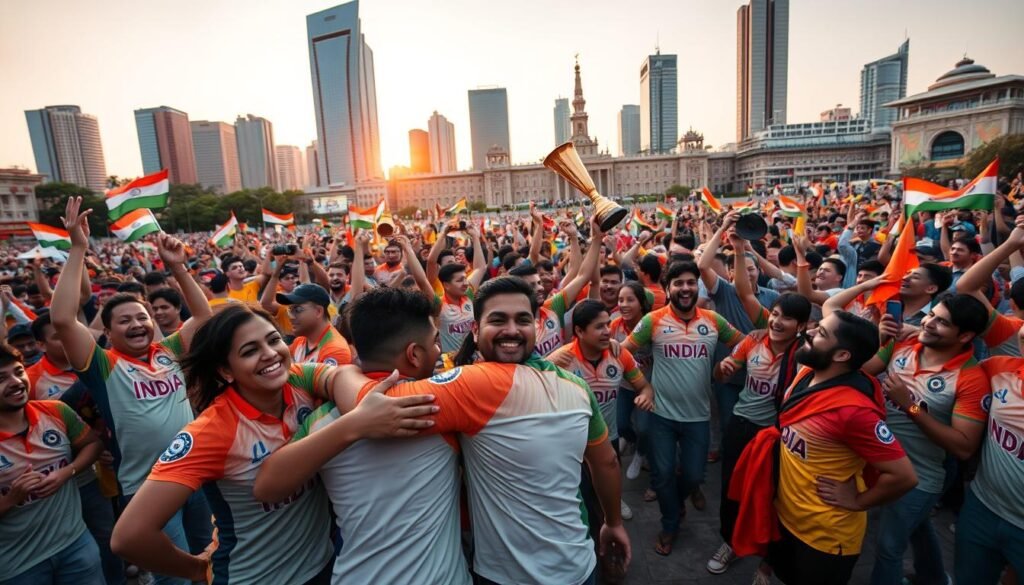Few moments in sport unite a nation like an unexpected win. Back in June 1983, a team of determined players rewrote history on the lush greens of Lord’s. Facing the mighty West Indies—a squad many called unbeatable—India’s squad defied 66-1 odds.
The emotional impact was instant. Kapil Dev lifting the World Cup became an enduring symbol of hope. Streets erupted in celebration as a country discovered its collective pride. Cricket wasn’t just a game anymore—it became a shared passion.
This triumph did more than earn a trophy. It reshaped how the world saw Indian cricket. From underdogs to champions, the journey inspired generations. The win laid the foundation for modern dominance, turning the sport into a national obsession.
The Improbable Dream: India’s Road to the 1983 World Cup
Expectations were so low that players had already planned their post-tournament vacations. Krishnamachari Srikkanth even booked his honeymoon during the tournament dates—hardly the move of a team expecting glory.
A Team of “No Hopers”
Past performances fueled the skepticism. In previous clashes, the mighty West Indies had crushed India by 202 runs and 10 wickets. The odds were 66-1—bookmakers saw them as filler, not fighters.
Resources matched the low hopes. Fourteen players shared one physiotherapist. Mohinder Amarnath doubled as a player-mentor. The BCCI’s investment? A fraction of today’s ₹15,000 crore IPL ecosystem.
Kapil Dev’s Unshakeable Belief
Amid the doubt, Kapil Dev stood firm. His pre-tournament speech was simple: “We’re not stars, but we can win if we play to potential.” His leadership blended tactical smarts with raw honesty.
He knew the team’s limits but focused on heart. “Fighters, not favorites,” he’d say. That belief—not resources—became their fuel.
By the time they reached England, the underdogs carried a quiet fire. No one noticed—yet.
Turning Points: Moments That Defied the Odds

History remembers the flashy wins, but the real magic lies in the unseen battles. The 1983 world campaign pivoted on three defining acts—each a masterclass in resilience.
The Unseen Hero: Kapil Dev’s 175* Against Zimbabwe
At 17/5, defeat seemed certain. Then Kapil Dev unleashed a fury of 16 fours and 6 sixes—75% of his 175* came in boundaries. A BBC strike erased the footage, but player diaries recount every blistering stroke.
“We saw glimpses of genius,” wrote Syed Kirmani. The innings wasn’t just runs; it was a psychological revolt against the mighty west’s shadow.
Madan Lal and Balwinder Sandhu’s Semifinal Heroics
Madan Lal’s 3/31 against England sealed their final berth. But Sandhu’s banana in-swinger to dismiss Greenidge? Poetry in motion. The ball curved like fate itself.
Viv Richards’ 80% strike rate meant nothing when Kapil’s running catch sent Lord’s into silence. One moment, two legends—colliding.
PR Man Singh: The Silent Architect
While stars shone, PR Man Singh worked backstage. Team meetings under oak trees. Pep talks during Kapil’s self-doubt. His playbook blended strategy with soul.
No trophy is lifted alone. From physios to tacticians, hearts and minds built this game-changing win.
The Final at Lord’s: How India Toppled the Mighty West Indies
On a rain-dappled afternoon at Lord’s, history waited to be rewritten. June 25, 1983, wasn’t just another day in sport—it was the moment a nation’s dream collided with destiny. Against the two-time champions, India’s 183 runs seemed a whisper in a storm. But whispers can become roars.
183 Runs and a Prayer
Syed Kirmani’s diary reveals Kapil Dev’s locker-room words: “They’ll chase shadows if we fight for every run.” The scorecard told a grim tale—Gavaskar’s 2 runs in 12 overs, wickets falling like autumn leaves. Yet, the team clung to belief.
Madan Lal’s 75mph cutter to dismiss Holding (98mph) wasn’t just skill—it was symbolism. The required run rate plummeted from 4.9 to 3.1, a statistical win before the final ball.
| Player | Contribution | Impact |
|---|---|---|
| Viv Richards | 33 off 28 balls | Momentum shifted post-dismissal |
| Mohinder Amarnath | 3/12 (7 overs) | Bowled through finger injury |
Kapil’s Catch: The Dagger to West Indies’ Heart
Richards’ swat off Madan Lal soared skyward—a moment frozen in time. Kapil Dev’s 20-yard sprint ended with a catch that silenced Lord’s. Clive Lloyd’s 1975/1979 dominance unraveled in that instant.
“The world stopped,” recalled Sandhu. Richards’ wicket wasn’t just a dismissal; it was a coronation.
Mohinder Amarnath’s Ice-Cold Finish
Bloodied fingers and all, Amarnath’s 7-over spell cost just 12 runs. His LBW of Michael Holding sealed the win—a 72mph cutter humbling raw pace. As Kapil was carried on shoulders, cricket’s new religion found its messiah.
The Lord’s balcony bore witness. Sachin Tendulkar, then 10, would later call it “the spark that lit a billion dreams.”
A Nation Transformed: The Emotional Aftermath

Overnight, cricket became more than a game; it was a shared identity. The win didn’t just change the landscape of sports—it rewrote how a country saw itself. From crowded alleys to quiet villages, hope replaced hesitation.
Streets of Joy: Fan Memories from 1983
Mumbai’s Marine Drive froze as fans clustered around radios. Doordarshan’s viewership leaped from 12% to 89% households—a record unbroken for years. “We danced till dawn,” recalls a shopkeeper from Chennai. The global stage finally noticed India’s passion.
A young Sachin Tendulkar watched the final on a neighbor’s TV in Bandra. That day, a 10-year-old’s dream took flight. By 1985, youth cricket enrollment surged 400%. Future legends like Anil Kumble traced their inspiration to that time.
Cricket as Religion: The Birth of a Billion Dreams
The victory turned playgrounds into temples. Kids picked up bats, dreaming of glory. Co-host rights for the 1987 World Cup were secured—credit to the 1983 team’s impact. The sport became a unifying force, bridging divides.
PR Man Singh, the team’s manager, noted: “We didn’t just win a cup; we won hearts.” The ₹2 lakh prize money paled against the cultural payoff. Today’s ₹40 crore bonuses trace their roots to this changed indian cricket ethos.
From Underdogs to Believers
Self-doubt faded as the win fueled a new mindset. The 1991 economic reforms drew confidence from this triumph—proof that India could compete globally. World cricket now had a powerhouse, not just participants.
The legacy? A nation that dared to dream. As Kapil Dev often said, “Belief is the first step to greatness.” That summer, 14 players taught a billion to believe.
The Legacy of 1983: How a Miracle Shaped Modern Indian Cricket
Legends aren’t born—they’re forged in moments of sheer will. The legacy of 1983 lives in today’s stadiums, where IPL’s $11bn buzz echoes that first world cup roar. Back then, cricket contributed 0.01% to India’s GDP; now, it’s 0.12%—proof of a sport turned economic force.
Seven ICC trophies followed, from Rahul Dravid’s grit to MS Dhoni’s cool. The BCCI’s revenue? A leap from $0.1m to $600m. Kapil’s Devils didn’t just win—they rewrote a nation’s playbook.
Virat Kohli put it best: “We stand on Kapil’s shoulders.” Every six, every cheer traces back to that summer. The odds were long, but determination was longer.




